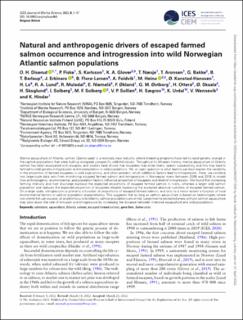| dc.contributor.author | Diserud, Ola Håvard | |
| dc.contributor.author | Fiske, Peder | |
| dc.contributor.author | Karlsson, Sten | |
| dc.contributor.author | Glover, Kevin Alan | |
| dc.contributor.author | Næsje, Tor | |
| dc.contributor.author | Aronsen, Tonje | |
| dc.contributor.author | Bakke, Gunnar O | |
| dc.contributor.author | Barlaup, Bjørn Torgeir | |
| dc.contributor.author | Erkinaro, J. | |
| dc.contributor.author | Florø-Larsen, Bjørn | |
| dc.contributor.author | Foldvik, Anders | |
| dc.contributor.author | Heino, Mikko Petteri | |
| dc.contributor.author | Kanstad-Hanssen, Øyvind | |
| dc.contributor.author | Lo, Håvard | |
| dc.contributor.author | Lund, Roar Asbjørn | |
| dc.contributor.author | Muladal, R. | |
| dc.contributor.author | Niemela, E. | |
| dc.contributor.author | Økland, Finn | |
| dc.contributor.author | Østborg, Gunnel Marie | |
| dc.contributor.author | Otterå, Håkon Magne | |
| dc.contributor.author | Skaala, Øystein | |
| dc.contributor.author | Skoglund, Helge | |
| dc.contributor.author | Solberg, Ingrid | |
| dc.contributor.author | Solberg, Monica Favnebøe | |
| dc.contributor.author | Sollien, Vegard Pedersen | |
| dc.contributor.author | Sægrov, Harald | |
| dc.contributor.author | Urdal, Kurt | |
| dc.contributor.author | Wennevik, Vidar | |
| dc.contributor.author | Hindar, Kjetil | |
| dc.date.accessioned | 2022-06-01T09:27:20Z | |
| dc.date.available | 2022-06-01T09:27:20Z | |
| dc.date.created | 2022-04-21T13:18:35Z | |
| dc.date.issued | 2022 | |
| dc.identifier.issn | 1054-3139 | |
| dc.identifier.uri | https://hdl.handle.net/11250/2997181 | |
| dc.description.abstract | Marine aquaculture of Atlantic salmon (Salmo salar) is a relatively new industry where breeding programs have led to rapid genetic change in the captive populations that were built up alongside conspecific wild individuals. Throughout its 50-years history, marine aquaculture of Atlantic salmon has been associated with escapes, and studies have shown that escapees may enter rivers, spawn successfully, and this may lead to farmed-to-wild genetic introgression and maladaptation in wild populations. Yet, an open question is what factors can best explain the variability in the proportion of farmed escapees in wild populations, and when present, which additional factors lead to introgression. Here, we combine two large-scale data sets from monitoring escaped farmed salmon and introgression in Norwegian rivers between 2006 and 2018 to model how anthropogenic, environmental, and population factors influence proportion of escapees and level of introgression.We found that increasing farming intensity and river discharge increase the expected proportions of escaped farmed salmon in rivers, whereas a larger wild salmon population size reduces the expected proportion of escapees despite increasing the expected absolute numbers of escaped farmed salmon. On a large scale, introgression is primarily a function of proportions of escaped farmed salmon, and only to a minor extent a function of local environmental factors or salmon population characteristics. This suggests that as long as salmon aquaculture is based on technologies where non-sterile fish can escape, all anadromous wild Atlantic salmon populations are at risk. Largemarine protected areaswithout salmon aquaculture may slow down the rate of intrusion and introgression by increasing the distance between intensive aquaculture and wild populations. admixture, aquaculture, Atlantic salmon, escaped farmed salmon, gene flow, Salmo salar. | en_US |
| dc.language.iso | eng | en_US |
| dc.rights | Navngivelse 4.0 Internasjonal | * |
| dc.rights.uri | http://creativecommons.org/licenses/by/4.0/deed.no | * |
| dc.title | Natural and anthropogenic drivers of escaped farmed salmon occurrence and introgression into wild Norwegian Atlantic salmon populations | en_US |
| dc.title.alternative | Natural and anthropogenic drivers of escaped farmed salmon occurrence and introgression into wild Norwegian Atlantic salmon populations | en_US |
| dc.type | Peer reviewed | en_US |
| dc.type | Journal article | en_US |
| dc.rights.holder | © 2021 The Authors | en_US |
| dc.description.version | publishedVersion | en_US |
| cristin.ispublished | true | |
| cristin.fulltext | original | |
| cristin.qualitycode | 1 | |
| dc.identifier.doi | 10.1093/icesjms/fsac060 | |
| dc.identifier.cristin | 2018170 | |
| dc.source.journal | ICES Journal of Marine Science | en_US |
| dc.relation.project | Andre: Miljødirektoratet | en_US |
| dc.relation.project | Egen institusjon: Norwegian institute for nature research (NINA) | en_US |
| dc.relation.project | Norges forskningsråd: 254852 | en_US |
| dc.relation.project | Andre: Fiskeridirektoratet | en_US |
| dc.relation.project | Norges forskningsråd: 216105 | en_US |
| dc.subject.nsi | VDP::Zoologiske og botaniske fag: 480 | en_US |
| dc.subject.nsi | VDP::Zoology and botany: 480 | en_US |

